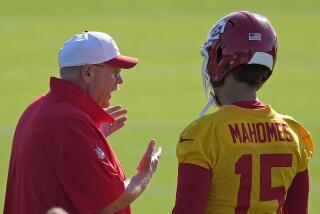PRO FOOTBALL : Notice of Expansion Portends Labor Peace
- Share via
As NFL commissioners, Pete Rozelle and his successor, Paul Tagliabue, have insisted that league expansion is impossible without labor peace.
That also has been the view of most club owners.
Accordingly, Tagliabue’s new position on expansion--he says it’s coming in 1993--is a signal that NFL peace is near, too.
Ram Vice President John Shaw and the eight other members of the NFL’s two labor committees met with Tagliabue in New York last week before the commissioner made his expansion announcement.
And, although a final report isn’t ready yet, the group’s majority proposal, which sets up a form of free agency for most NFL players, apparently impressed Tagliabue.
Next:
--The two committees will meet again in late April to consider and, if possible, develop a formal labor plan.
--The owners expect to act on it at their May meeting in Dallas.
--If palatable to them and the players, it could lead to a new player-owner collective bargaining agreement this summer.
The last such agreement expired in August, 1987. The NFL has played three seasons without one during a stormy labor interlude that has held up expansion, realignment and other league changes and improvements.
“There was a consensus on many points,” Mike Lynn, president of the Minnesota Vikings, said of last week’s labor conferences. “Our mandate is to come up with a (plan). I expect that we’ll submit one even if it’s by a bare majority.”
Lynn and Shaw are on the new labor committee, along with Steve Gutman, president of the New York Jets, and Bill Polian, vice president of the Buffalo Bills.
Chairman Hugh Culverhouse of the Tampa Bay Buccaneers is on the executive labor committee along with a Cincinnati Bengal leader, Mike Brown, and three other owners--Dan Rooney of the Pittsburgh Steelers, Wellington Mara of the New York Giants and Bill Bidwill of the Phoenix Cardinals.
The league is divided on three principal issues. The owners want some kind of wage scale and payroll cap. The players want a meaningful kind of free agency.
They’re trying to get it all done within a framework of player-owner revenue-sharing by pooling all TV income and gate receipts.
The NFL project that is often called Plan B free agency--although it is more like an early cut of expendable athletes--will die with this year’s crop of player changes, if a 1990 collective bargaining agreement is signed.
As a project, it has been both costly and disruptive. The 28 teams have lost an average of six veterans apiece this spring. And as a group, those changing sides have nearly doubled last year’s salaries.
In the Plan B system, each club protected 37 players at the end of the 1989 season and lost rights to an average 17 others.
Last week at Plan B’s 1990 deadline, 184--or 37.5%--of the 490 available players had moved to other clubs.
Last year, 229--or 36.9%--of 619 moved. Under different rules, the clubs in 1989 made available an average of 22 players.
During the 1990 Plan B season, the talent-heavy San Francisco 49ers again strengthened the league’s strongest bench, agreeing to pay former New Orleans cornerback Dave Waymer an average of $600,000 in each of the next three years. The 49ers also invested in former Buffalo nose tackle Fred Smerlas and four others.
Less discriminating, the Dallas Cowboys poured out their millions for 16 unheralded 1989 bench-sitters, Tony Spears among them. A taxi-squad defensive lineman earning $1,000 a week at Houston last season, Spears signed with the Cowboys for an average of $318,000 in each of the next two seasons.
The Green Bay Packers, who led the Plan B chase with 21 recruits a year ago, sustained their faith in the system by signing 13 this time. Only one club, the Indianapolis Colts, refused to participate.
The two that refused a year ago, Cincinnati and Chicago, signed two and one, respectively, this year. Both clubs need help, but regard Plan B as an unreasonably extravagant lottery.
If this year’s NFL draft were today instead of April 22, the first two players selected would be Alabama linebacker Keith McCants and Penn State running back Blair Thomas.
There is only one other blue chip prospect at the top, USC linebacker Junior Seau--although, on draft day, a quarterback or running back could go ahead of him.
That tells you the draft is a very shaky one in which, from the start, every pro team will be guessing.
McCants and Seau are both leaving school as juniors. And Thomas is coming off a knee injury so severe that it cost him the 1988 season.
So far, the NFL has accepted 36 productive college juniors for consideration this month, converting the draft into a grab bag.
The truth is that every NFL personnel department has at least one horror story to tell about the year it would have picked a junior first--had he been available--only to discover, 12 months later, that the guy was badly overrated after all.
The problem for the pros is that on college teams, most undergraduates haven’t taken the hits that enable them to be classified.
A good college prospect usually plays his senior season as a marked man. Only then, when he is under fire every Saturday, can he be intelligently evaluated.
Thus, nobody really knows whether Blair Thomas or Florida’s Emmitt Smith or somebody else is the best running back this year, or whether, for instance, Illinois’ Jeff George is the best quarterback.
This is the nobody-knows draft.
More to Read
Go beyond the scoreboard
Get the latest on L.A.'s teams in the daily Sports Report newsletter.
You may occasionally receive promotional content from the Los Angeles Times.










